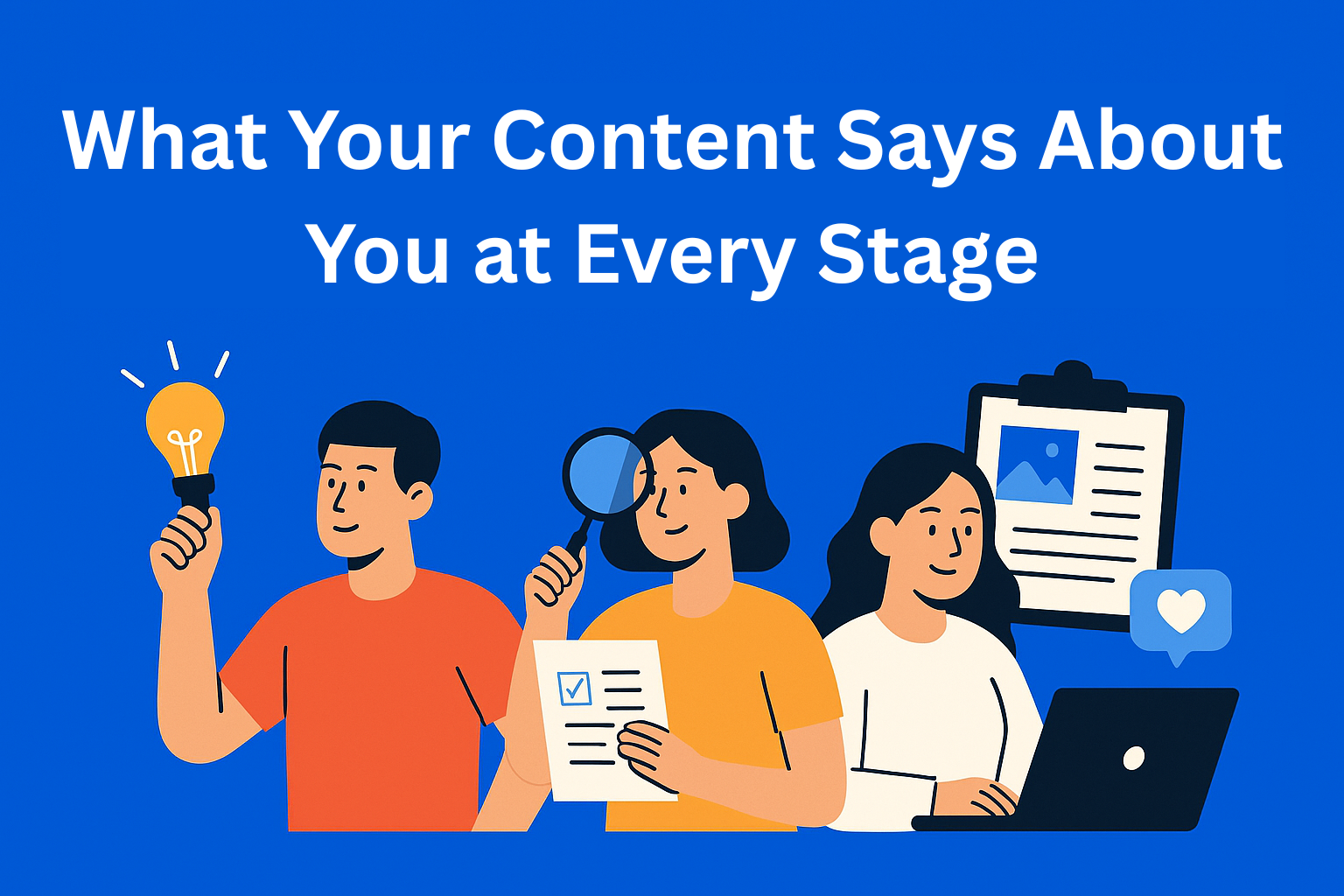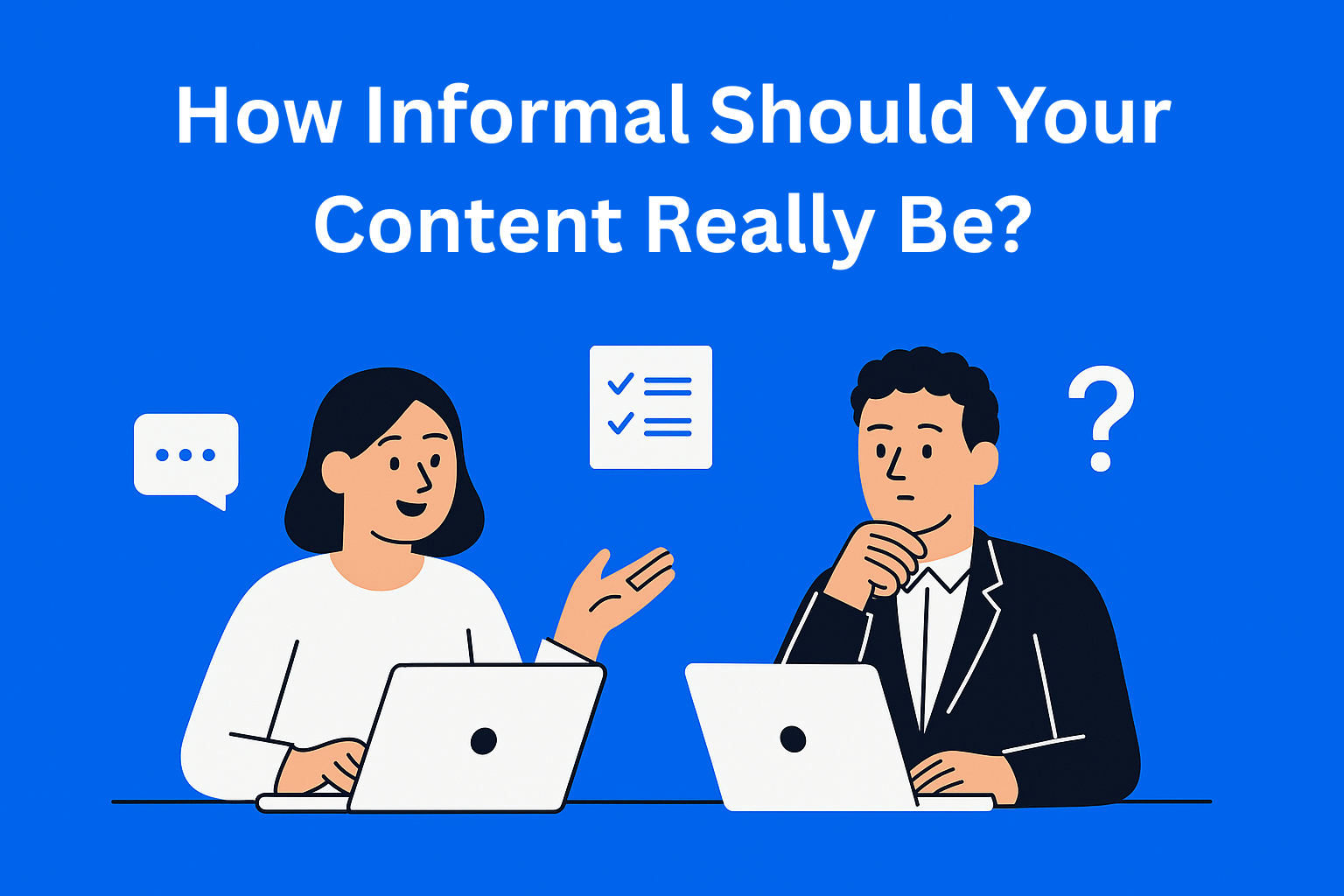What Your Content Says About You at Every Buyer Stage
Your content tells your brand’s story at every stage of the buyer journey - awareness, consideration, and decision. Learn how to craft content that builds trust, reflects your values, and turns readers into loyal customers.

Every piece of content tells a story. Not just about your product, but about who you are as a brand - your values, your tone, and your priorities. Whether it’s the first blog someone reads or the final case study before purchase, your content shapes how people see you. It’s the voice of your brand in action, and it speaks loudly at every stage of the buyer journey: awareness, consideration, and decision.
In this blog, we’ll break down what your content really says about you at each stage and how to make sure it reflects the brand you truly want to be.
Key Takeaways
- Content reflects your brand identity - Every piece of content sends a message about your values, tone, and trustworthiness.
- Each stage needs a different focus - Awareness = helpful and friendly, Consideration = transparent and informative, Decision = confident and reassuring.
- Consistency builds trust - Keep your tone, visuals, and values aligned across all stages and channels to create a seamless experience.
- Common mistakes weaken credibility - Selling too soon, mixed messaging, and lack of proof make your brand feel disjointed or untrustworthy.
- Intentional strategy shapes perception - Define your brand voice, match content to each journey stage, and update regularly to stay aligned with your audience.
1. Awareness Stage: When People Are Just Discovering You
In the awareness stage, potential customers don’t yet know who you are. They might not even realize they have a problem that needs solving. At this stage, they are looking for information, inspiration, or answers. This is your chance to introduce your brand by being helpful, not pushy.
Your content marketing in this stage should focus on education. The goal isn’t to sell - it’s to inform. Think of:
- Blog posts that answer common questions,
- Short videos that explain industry terms, or
- Social media posts that offer tips and simple solutions to everyday problems.
When people find your content useful, they start to associate your brand with trust and value.
If your early-stage content feels too salesy, it might turn people away. Instead, show that you understand their challenges. For example, if you’re a digital marketing agency, instead of saying “Hire us to grow your business,” offer something like “5 Simple Ways to Improve Your Social Media Reach.” This approach builds trust and brand awareness naturally.
Your content at this stage should say: We understand you. We’re here to help.
Use clear language, real examples, and a friendly tone. This helps your audience see you as approachable and knowledgeable. Every piece of content (from a blog post to a social media caption) should make readers think: “These people really get me.”
2. Consideration Stage: When People Start Comparing Options
Once your audience becomes aware of their problem, they enter the consideration stage. Here, they know they need a solution and are exploring different options. At this point, your brand story becomes especially important. People are comparing you to others, and your content can build or break trust.
The key in this stage is depth and transparency. Your content should provide simple and useful information that helps people make decisions more easily. You’re no longer just spreading awareness - now you’re showing why what you do makes sense.
Use formats like:
- Case studies,
- E-books, or
- Comparison guides.
These allow you to explain in more detail how your product or service solves real problems. If you can include results from real clients or their testimonials, even better. Real examples and experiences show value and help people build trust.
For example, someone looking for a project management tool might read a blog comparing the features of different platforms or download a simple guide explaining which software works best for their team. If your content explains things clearly instead of confusing them, your brand becomes a trusted advisor.
Your content in this stage should say: We know what we’re doing, and we care about your success.
Avoid complicated language and jargon. Instead, focus on honest and clear communication. People appreciate brands that speak simply. Authenticity and transparency make you stand out more than any marketing trick.
It’s also important to keep a consistent tone. If your awareness-stage content was friendly and helpful, your consideration-stage content should stay the same - just with more depth and confidence. It’s like moving from a casual chat to a thoughtful conversation.
3. Decision Stage: When the Buyer Chooses
The decision stage is where everything comes together. Your audience now knows their problem, has explored available solutions, and is deciding whom to trust. At this stage, every detail matters - the tone of your emails, the clarity of your website, and the strength of your testimonials all shape the final impression.
Your content in this stage should provide reassurance and trust. The buyer should feel that choosing your brand is a good and safe decision. Your goal is to make that choice easy and clear.
Here, practical and persuasive content works best:
- Detailed case studies
- Product demos
- Free trials, or
- Customer success stories
This kind of content doesn’t just show that your product works - it shows that you’re a partner, not just a seller.
Your content in this stage should say: We’re reliable, capable, and invested in your success.
If you’re confident but not aggressive, people will notice. Honest confidence has great power. Instead of saying “Buy now!”, show why people love your brand - through customer stories, user-generated content, or behind-the-scenes videos that bring your brand closer to people and help them feel more secure.
Consistency is key here, too. The tone, visuals, and messages from earlier stages should stay familiar and easy to recognize. When the buyer’s experience feels the same across all stages, you appear professional and trustworthy - and that often leads to a purchase.
How to Keep Your Brand Consistent Across All Stages
Although each stage of the buyer journey has its own focus, one thing must always stay the same: your brand voice. Whether someone is discovering you for the first time or ready to buy, they should feel like they’re talking to the same brand across every channel.
That consistency builds recognition - and recognition builds trust.
Here’s how to make that happen:
- Tone: If you start friendly and casual, don’t become overly formal later.
- Values: Let your values show naturally in every piece of content. If you support small businesses, show it through stories and examples.
- Visuals: Keep similar colors, images, and design across platforms. It helps people recognize you faster.
- Message: Focus on what makes your brand unique. Repetition is useful because it helps people remember you.
A consistent brand experience helps your audience feel safe because they know what to expect from you at every stage.
Common Mistakes Brands Make in Their Content Strategy
Even brands with the best intentions can go off track. Here are the most common mistakes when creating content for the buyer journey:
- Selling too early - If you try to sell right away, people will pull back because they’re not ready yet. At first, they want to understand the problem and get helpful information, not a sales pitch.
- Inconsistent messaging - If you change tone, style, or values across stages, your audience will get confused. People like when a brand is steady and predictable. They want to know how you act and what to expect every time.
- Ignoring proof - When people are considering a purchase, they look for examples and results. If you don’t show proof that your product or service really works, you’ll seem unreliable.
- Forgetting emotions - People don’t decide based only on facts; emotions matter too. Your content should build trust and show that you understand them, not just give information.
- Not measuring results - If you don’t track engagement or sales, you won’t know what works and what needs improvement.
How to Make Your Content Reflect the Brand You Want to Be
It’s not just about how much content you create - it’s about making sure that content matches who your brand really is. Here are a few simple steps to help you:
Define Your Brand Personality
Ask yourself: if your brand were a person, how would it talk? How would it treat others? Write down three to five traits that describe it - maybe “reliable,” “honest,” “curious,” or “confident.” These are your guidelines.
Map Out the Buyer Journey
Understand what your audience needs at each stage. Create a simple table that connects content types with stages. For example:
- Awareness ➡ Blogs, infographics, social media posts
- Consideration ➡ Case studies, webinars, guides
- Decision ➡ Testimonials, demos, FAQ pages
Review and Refresh Regularly
Your content should grow with your audience. From time to time, check your tone and topics to make sure they still match your goals and values.
Use SEO Naturally
Use keywords naturally in your writing. Add them only where they fit nicely into the sentence. Keywords aren’t just for Google - they help people better understand what your content is about. They guide both readers and search engines to your message.
Conclusion
Your content isn’t just a marketing tool - it shows who you are as a brand and what you stand for. Each stage of the buyer journey is a chance to show a different part of that story:
- In the awareness stage, you show that you understand people and offer helpful advice.
- In the consideration stage, you show that you’re honest and know what you’re doing.
- In the decision stage, you show that you’re reliable and worthy of trust.
When all of this comes together, people don’t just buy your product - they believe in you.
So take a moment to look at your content. What does it say about you? Is it the image of your brand you want people to see?
Your content has great power. Make sure it delivers the right message, at the right time, in the right way.






